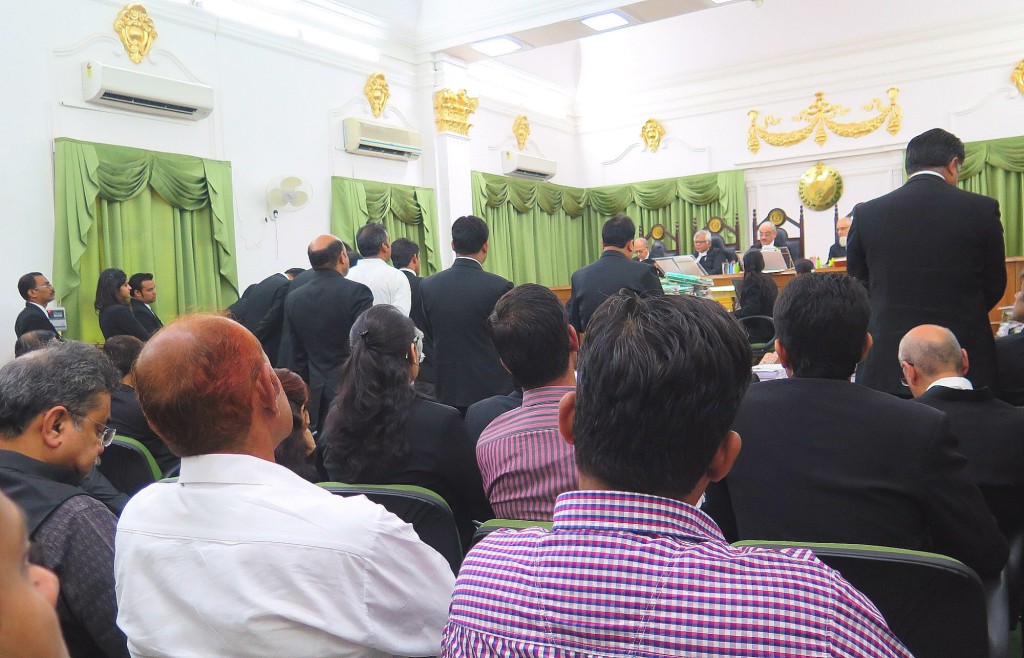
SHILLONG, India — India’s National Green Tribunal, a judicial body with legal authority that ranks just below India’s Supreme Court, is quickly emerging as one of the world’s most important forums for the idea that economic advancement is tightly wired to public safety, and the security of water, air, and land.
Established by India’s Supreme Court and legislated into existence and a source of funding by Parliament in 2010, the new court gained a formidable home office eleven months ago. The NGT’s building, constructed over a century ago as the residence of a regional prince, and formerly the national office of India’s Human Rights Commission, sits prominently near the center of the capital district that also houses the President’s Estate and the Supreme Court.
Prior to the election of Prime Minister Narendra Modi in May, India’s leadership took pains to recruit great jurists and technical specialists to serve on the bench. The government invested in decorating the Tribunal’s main Courtroom Number 1 with green carpet, green curtains, green upholstered chairs, gold filagree on decorative cornices, and a gold seal above the judicial bench. The ornamentation, poorly lit in an Indian government sort of way, is authentically earnest and more than enough to convey institutional significance, and sound and independent legal judgment.
Yet even with all the green and gold serving as glitter on the symbolic robe of impartial justice, the colors aren’t sufficient to hide the doggedness that really drives the spirit of India’s newest court. Just a few days of attending NGT hearings this month reveals a 17-member bench, comprised of seven judges and ten of India’s top science, engineering, and technical experts, driven by righteous zeal.
There is, in fact, an undercurrent of spiritual fervor in the poorly ventilated courtroom, illumiinated by harsh fluorescence, and jammed with lawyers in spotless white shirts and pitch black suits. They huddle like penguins, straining to hear the unamplified back and forth between the grey-bearded judges and the much younger lawyers. The scene feels a lot like the heated, crowded, airless, determined Rosh Hashanah stir of a Brooklyn synagogue.
For a journalist who’s covered a good number of important American environmental cases, from the 1979 Three Mile Island nuclear disaster to the 2010 Gulf oil spill, there is a lot to admire in the NGT’s short history and lengthening list of blockbuster rulings.
First is its origin. India’s Supreme Court, buried under a landslide of green cases, needed help from a judicial body that could immediately command respect. India’s government, besieged by rising public concern about the country’s deteriorating cities and natural bounty, supported the idea of an independent senior court that focused on solving green conflicts. The government also financed a network of regional NGTs with sitting judges and equally broad powers. The NGT’s mission: compel India’s state and national resource agencies, and the industrial executives they are supposed to oversee, to abide by the broad and largely ignored tapestry on Indian environmental law.

Two other nations — New Zealand and Australia — have national environmental courts. The United States and other western nations enforce the law through various levels of district, regional, appellate, and supreme courts. Arguably no court system in the world now is as active, or as determined to secure environmental stability, and raise standards of behavior and practice, as India’s National Green Tribunal.
Last year the Tribunal shut down India’s sand mining industry because of the damage it was doing to India’s rivers and streams. In April, the NGT shut down the entire coal mining sector in Meghalaya, a northeast coal mining state, because of the toll unregulated, and what the court called “illegal mining,” was taking on water and the industry’s workers. It was the first time a court anywhere in the world had shut down a state-level fossil fuel industry. Both industries were ordered to dramatically change how they did business or they wouldn’t do business again.
During just the three mornings of hearings that I attended, the four sitting justices in Court Number 1 blocked construction of a big new coal-fired power plant because its builders did not comply with the permitting requirements. The court fined the chairmen of pollution control boards in eight states across northern India for refusing to comply with the requests for information on air emissions filed by several plaintiffs groups. The judges then ordered the offenders to appear before them with the requested information or face jail time.
If that wasn’t impressive enough, the Tribunal also accepted the Supreme Court’s referral of a 29-year-old case to limit water pollution in the sacred Ganga River Basin, source of the Ganges River. The High Court, frustrated by the slow progress in removing pollutants from India’s mother river, asked the Tribunal to enforce water quality statutes against industries.
If the Tribunal succeeds, the High Court is likely to turn the rest of the case over to its lower court colleagues to go after municipalities and headwater polluters to require construction of wastewater treatment systems. Its entirely possible that the NGT could succeed in turning one of the dirtiest rivers in the world into a much cleaner source of national pride and new jobs.
As you might imagine, such active and clear interpretation of the requirements of environmental law is annoying state officials and industrialists. As one of his first acts as India’s leader, Prime Minister Modi appointed a special commission to evaluate the effects of the NGT on India’s capacity to develop. A report is expected in late January. I’m here in India for 17 days and spent much of last week interviewing authorities to assess NGT’s influence and report on the outcomes of any effort to weaken its authority. Look for my article in December on Circle of Blue’s Website.
Ritwick Dutta, a 43-year-old environmental attorney, who is litigating many of the court’s most significant cases on the side of the public interest, told me he doubts the prime minister will meddle with the NGT. The court’s justices, in private conversations with me, said the same thing. India’s deteriorating natural bounty, its horrid water quality, foul air, scarred land, and diminished forests are significant factors in the unraveling of the Indian economy. The national economic growth rate is less than half of what it was in the first decade of the century, and steadily declining. The country’s capacity to attract investment from domestic and foreign businesses is tied to rehabilitating India’s physical condition — its worn cities, dirty streets, littered countryside.

Dutta, one of the dozen or so senior attorneys in India’s tiny environmental bar, appears for arguments almost daily before the NGT. He said he is so busy litigating 350 or so cases a year that he has little time to reflect on the influence he and the court are having. In the moments after the NGT ruled in his favor and ended a developer’s bid to build a new coal-fired power plant in central India, Dutta and his legal colleagues didn’t even shake hands. There was no celebration at all.
He invited me back to his office for a 90-minute interview. “That will give me enough time later to prepare for arguments tomorrow,” he said, his eyes dark and serious, and without a brush stroke of a smile.
— Keith Schneider

One thought on “India’s National Green Tribunal Challenges Government and Industry To Follow The Law”